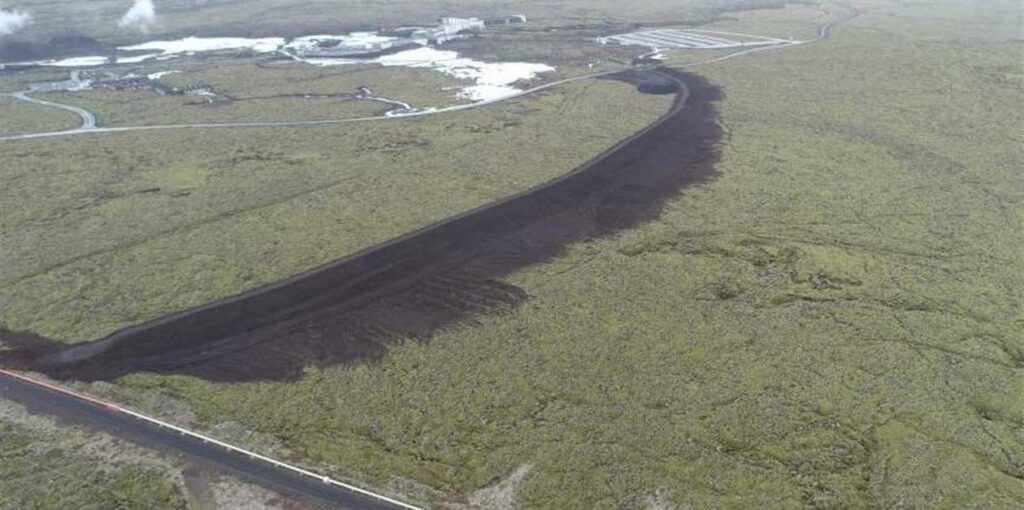A member of the emergency team looks at the open fissure in the ground in the evacuated town of Grindavik, Iceland on 23 November 2023. Photo by Raul Moreno / SOPA Images/ Reuters.
“The week before there was something showing on the instrument. We cleared the site immediately. It happened very quickly. We sounded the alarm, and everyone drove away,” Guđmundsson says. “It was a false alarm and four hours later we started work again. It was a good thing we saw how quickly we can evacuate.”
“Last week we had bad weather for a day and a half, and the Meteorological Institute told us that they would have difficulty in monitoring air quality because they could not tell if the changes were due to the weather or to volcanic activity,” he adds. “So, we left the area because it was not safe to have the workers there.”
One of the hardest things to work with, Guđmundsson says, is the uncertainty about where exactly the eruption will occur. Teams must work in the knowledge that the barriers they are building could be too far out from the spot of the eruption if it occurs inside the area they are currently protecting.
“The scientists don’t know exactly where the eruption will take place,” he says. “The first suggestion was in the land next to the Blue Lagoon because we know the land has risen here vey quickly, I think 1cm per day or something. But then all of a sudden the most likely scenario has moved slightly.”
A plan years in the making
Although construction work on the lava barriers only started in mid-November as hundreds of earthquakes started to shake the area, Guðmundsson says that Verkís has been working on plans for the barriers for years.
The company, which is one of the largest and oldest engineering firms in Iceland, has been testing different scenarios to estimate the flow of lava using computer software models and designing ways to protect critical infrastructure under each scenario.
Using the model, Verkís designed barriers as wide mounds of earth and rubble erected on the highest ground available which protect the infrastructure from eruptions coming from various directions and are themselves designed to withstand earthquake tremours.
Verkís had already submitted a proposal to build the barriers to the Icelandic government before the latest spate of earth tremours began in October. However, the government only made the funds available to pay for the construction work in November as fears of an imminent eruption mounted and the town of Grindavík had to be evacuated.
On November 14 Iceland’s parliament approved a new tax on all homeowners in the country for the next three years to fund the construction.
The tax is expected to raise at least 1bn ISK (€6.5m) a year over the next three years by taxing homeowners an additional 0.08% on the fire insurance value of their properties, equating to an additional €52 a year for a property worth €650,000.
“It would have been better to build the barriers beforehand and not after some eruptions had started,” admits Guðmundsson. “But we need to everything we can to protect this infrastructure. We have 30,000 people living in this area and the hot water to heat all of these houses is only coming from this power station. So if the plant gets damaged we have no way of heating these homes. It is not possible for us to heat all of these homes with electricity. The current systems don’t have the capacity.”
Guđmundsson adds that Verkís has also drawn up proposals for barriers to be built protecting the nearby town of Grindavík from future eruptions. Grindavík currently remains empty after the entire town’s population of 3,000 people was evacuated in November when thousands of earthquakes rocked the area and tore huge chasms in the streets.
Indeed, Verkís can already boast some experience with previous lava barriers. Guđmundsson says that in 2021 the company erected five small barriers measuring just a few hundred meters which partially succeeded either delaying or stopping lava flows. The design of the barriers was informed by previous work in both Hawaii in the USA and Mount Etna in Italy where engineers in the 1950s, 1960s and 1990s succeeded in protecting some infrastructure from lava flows.
“Two of the barriers were designed to work like dams. They stopped the lava for a few weeks. So they delayed the lava but in the end it overflowed because they were only eight meters high,” Guđmundsson says. “At that time the lava was flowing like a pulse. It flowed for maybe a week and then we got some days off.”
“Then we had two barriers which worked by diverting the lava,” he adds. “They worked and stopped the lava from going into the places we didn’t want it to go. The fifth one was a dam in front of a valley – and in that case the lava stopped before it reached the barrier.”
Although Iceland is one of the most geologically active regions in the world with more than 30 active volcanic sites across the country, until 2020 the last time the Reykjanes Peninsula experienced volcanic activity was between roughly the years 800 and 1240. However, since then the peninsula has experienced eruptions in 2021, 2022 and July 2023 which sent lava flowing into uninhabited valleys about 10km east of current activity.
For Guđmundsson and the teams frantically building the barriers, it is not a question of if the next eruption takes place but when.
“We know that an eruption will come,” says Guđmundsson. “We modelled how the barriers would perform under eight different scenarios using the computerised lava flow models and of those eight, six of the scenarios showed that the barriers protected the power plant. So we hope it will protect it for the next years or tens of years.”
Form placeholder
Source link : https://www.constructionbriefing.com/news/the-construction-teams-working-to-hold-back-a-volcano/8033447.article
Author :
Publish date : 2023-12-06 08:00:00
Copyright for syndicated content belongs to the linked Source.
